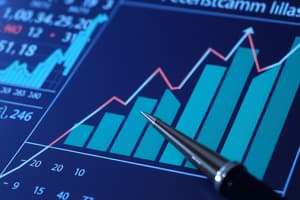Podcast
Questions and Answers
Why is demand estimation and forecasting needed?
Why is demand estimation and forecasting needed?
To predict the future demand and assess its effect on the operation of the firm/market.
What are the stages in demand estimation and forecasting?
What are the stages in demand estimation and forecasting?
- Identify the Market/Product 2. Collect the Data 3. Select Methods 4. Implement Methods 5. Evaluate Methods 6. Use Forecast and Validate
What are some factors to consider in demand estimation?
What are some factors to consider in demand estimation?
Time frame, Level of demand forecasting, General or Product specific forecast, Types of products, Product or market-specific factors
What are the types of forecasting methods?
What are the types of forecasting methods?
Name one type of qualitative forecasting method.
Name one type of qualitative forecasting method.
Why do consumers prefer new goods even at high prices?
Why do consumers prefer new goods even at high prices?
What is the Delphi method in demand forecasting?
What is the Delphi method in demand forecasting?
What are the two main approaches in demand estimation?
What are the two main approaches in demand estimation?
What do Time Series Models consider in demand forecasting?
What do Time Series Models consider in demand forecasting?
What do Casual Models assume in demand forecasting?
What do Casual Models assume in demand forecasting?
What is the Trend Projection Linear Trend equation used in Time Series models?
What is the Trend Projection Linear Trend equation used in Time Series models?
How does the Market Research stage in demand estimation differ from the Delphi method?
How does the Market Research stage in demand estimation differ from the Delphi method?
What is demand analysis and why is it important in economic analysis?
What is demand analysis and why is it important in economic analysis?
How does the equilibrium position relate to demand and supply?
How does the equilibrium position relate to demand and supply?
What role do market forces play in a country's economic conditions?
What role do market forces play in a country's economic conditions?
What are the types of demand based on consumer behavior?
What are the types of demand based on consumer behavior?
Can you provide an example of autonomous demand?
Can you provide an example of autonomous demand?
What distinguishes durable goods demand from non-durable goods demand?
What distinguishes durable goods demand from non-durable goods demand?
Flashcards are hidden until you start studying
Study Notes
Types of Goods
- Consumers prefer new goods even at high prices (CD)
- Seasonal goods: products with quantity and price fluctuations over time (e.g., ice-cream)
- Goods in short supply: limited availability, difficult to obtain (e.g., antiques)
Demand Forecasting
- Definition: estimation of a future situation or event under given conditions
- Tool for decision-making
- Purpose:
- Predict future demand and assess its effect on operations
- Reduce uncertainty, plan production, allocate resources, and formulate marketing strategies
Stages of Demand Estimation and Forecasting
- Identify the market/product
- Collect data
- Select methods
- Implement methods
- Evaluate methods
- Use forecast and validate
Factors to Consider in Demand Estimation
- Time frame: short-term, medium-term, or long-term
- Level of demand forecasting: macro-level, industry-level, or firm-level
- General or product-specific forecast
- Types of products: producer goods, consumer goods, services
- Product or market-specific factors: competition, market conditions, consumer psychology
Types of Forecasting Methods
- A. Qualitative Methods:
- Executive Opinion: collective forecast by managers/executives
- Market Research: systematic method involving questionnaires, surveys, sampling, and information analysis
- Delphi Method: consensus-based forecast involving experts
- B. Quantitative Methods:
- Time Series Models: predicting future demand based on past patterns
- Casual Models: assuming relationships between variables to predict demand
Time Series/Trend Projection
- Linear Trend: Y = a + bX, where Y is demand, X is time period, a is intercept, and b is slope coefficient
Demand Analysis
- Important part of economic analysis
- Manufacturers produce and supply goods to meet demand
- Demand and supply forces give dynamism to the country's economic conditions
- Types of demand:
- Direct demand: goods/services satisfying individual wants directly (e.g., fabric)
- Indirect demand: goods/services needed for manufacturing and satisfying consumers indirectly (e.g., cotton)
- Derived demand: desire for products/services determined by other activities (e.g., petrol for cars)
- Autonomous demand: demand for a product/service not affected by other products/services (e.g., mobiles)
- Durable goods demand: used more than once, providing a stream of services over time (e.g., TV)
- Non-durable goods demand: single use, consumed immediately (e.g., band-aid)
Studying That Suits You
Use AI to generate personalized quizzes and flashcards to suit your learning preferences.




